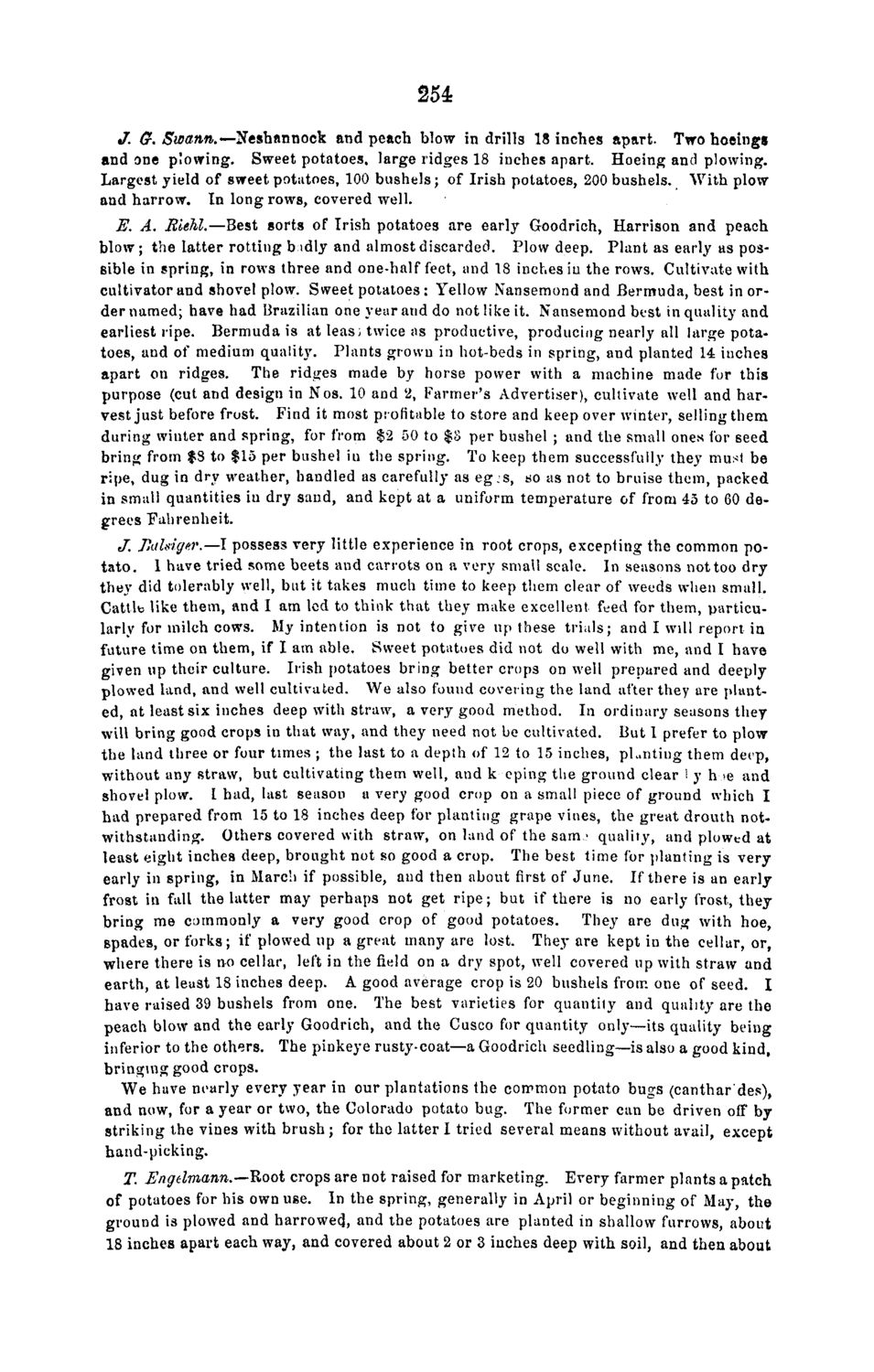| |
| |
Caption: Board of Trustees Minutes - 1868
This is a reduced-resolution page image for fast online browsing.

EXTRACTED TEXT FROM PAGE:
254 J. # . Swann.— Neshannock and peach blow in drills 18 inches apart. Two hoeingg and one plowing. Sweet potatoes, large ridges 18 inches apart. Hoeing and plowing. Largest yield of sweet potatoes, 100 bushels; of Irish potatoes, 200 bushels. With plow and harrow. In long rows, covered well. E. A. Rlehl.—Best sorts of Irish potatoes are early Goodrich, Harrison and peach blow; the latter rotting b idly and almost discarded. Plow deep. Plant as early as possible in spring, in rows three and one-half feet, and 18 inches in the rows. Cultivate with cultivator and shovel plow. Sweet potatoes: Yellow Nansemond and Bermuda, best in order named; have had Brazilian one year and do not like it. Nansemond best in quality and earliest ripe. Bermuda is at leas; twice as productive, producing nearly all large potatoes, and of medium quality. Plants grown in hot-beds in spring, and planted 14 inches apart on ridges. The ridges made by horse power with a machine made for this purpose (cut and design in Nos. 10 and 2, Farmer's Advertiser), cultivate well and harvest just before frost. Find it most profitable to store and keep over winter, selling them during winter and spring, for from $2 50 to $3 per bushel ; and the small ones for seed bring from $S to $15 per bushel iu the spring. To keep them successfully they must be ripe, dug in dry weather, handled as carefully as e g . s , so as not to bruise them, packed in small quantities iu dry sand, and kept at a uniform temperature of from 45 to 60 degrees Fahrenheit. J. Jlaldgev.—l possess very little experience in root crops, excepting the common pot a t o . 1 have tried some beets and carrots on a v^vy small scale. In seasons not too dry they did tolerably well, but it takes much time to keep them clear of weeds when small. Cattlb like them, and I am led to think that they make excellent feed for them, particularly for milch cows. My intention is not to give up these trials; and I will report in future time on them, if I am able. Sweet potatoes did not do well with me, and I have given up their culture. Irish potatoes bring better crops on well prepared and deeply plowed land, and well cultivated. We also found covering the land after they are planted, at least six inches deep with straw, a very good method. In ordinary seasons they will bring good crops in that way, and they need not be cultivated. But 1 prefer to plow the land three or four times ; the last to a depth of 12 to 15 inches, planting them deep, without any straw, but cultivating them well, and k eping the ground clear 1 y h >e and shovel plow. I had, last season a very good crop on a small piece of ground which I had prepared from 15 to 18 inches deep for planting grape vines, the great drouth notwithstanding. Others covered with straw, on land of the sam.' quality, and plowed at least eight inches deep, brought not so good a crop. The best time for planting is very early in spring, in March if possible, and then about first of June. If there is an early frost in fall the latter may perhaps not get r i p e ; but if there is no early frost, they bring me commonly a very good crop of good potatoes. They are dug with hoe, spades, or forks; if plowed up a great many are lost. They are kept in the cellar, or, where there is no cellar, left in the field on a dry spot, well covered up with straw and earth, at least 18 inches deep. A good average crop is 20 bushels from one of seed. I have raised 39 bushels from one. The best varieties for quantity aud quality are the peach blow and the early Goodrich, and the Cusco for quantity only—its quality being inferior to the others. The pinkeye rusty-coat—a Goodrich seedling—is also a good kind, bringing good crops. We have nearly every year in our plantations the common potato bugs (canthar'des), and now, for a year or two, the Colorado potato bug. The former can be driven off by striking the vines with b r u s h ; for the latter I tried several means without avail, except hand-picking. T. Fngdmann.—-Hoot crops are not raised for marketing. Every farmer plants a patch of potatoes for his own use. In the spring, generally in April or beginning of May, the ground is plowed and harrowed, and the potatoes are planted in shallow furrows, about 18 inches apart each way, and covered about 2 or 3 inches deep with soil, and then about
| |